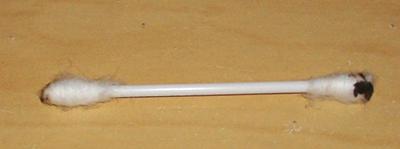Too Much Dog Ear Wax
by Vera
(San Diego, CA)
Reader Question: Excessive Dog Ear Wax
I recently had my vet examine my poodle/mix because he was batting at his ears excessively. The exam showed he had a large wax build-up in one ear only. His ears were flushed to remove the wax and home we went.
About one week later I went to clean his ears, carefully using cotton swabs and found the same ear filled with reddish brown wax. Now,approximately every four to five days I have to clean out what seems to me to be way too much wax.
I am using at least four swabs (both ends) to remove the wax. I am afraid that I could be pushing the wax in deeper and don't want to make things worse.
Is this normal and is it normal for only one ear to have this much wax? My dog is not batting at his ears but still I am concerned. Also,I rub his ears alot because he just loves it.
Could this be harmful to him or could this cause wax build-up?
Veterinarian Suggestion on Dog Ear Wax Buildup
Hi Vera,
I do not think that rubbing your dog’s ears is causing the build-up that you describe, but it probably feels so good to him because something is amiss with his ear(s).
Did your veterinarian look at the material he or she pulled out of your dog’s ear under the microscope? It is possible that your dog could have a yeast or bacterial infection or perhaps ear mites. A microscopic examination is the best way to diagnose these conditions.
Assuming your dog’s ears are healthy (no infection or mites), he simply could be making more ear wax than normal in that one ear. If that is the case, I would recommend against using Q-tips since they can push material deeper into the canal and even cause the eardrum to rupture. Instead, fill your dog’s ear canal with a gentle cleaner (Cerumene is a good one for removing wax), cover the canal with the flap of his ear, and gently massage for 10-15 seconds. Let your dog shake his head (you probably want to do this outside!) and then wipe away the material you can reach with a tissue wrapped around your finger.
Regards,
Jennifer Coates, DVM
Join in and write your own page! It's easy to do. How? Simply click here to return to Ear.


